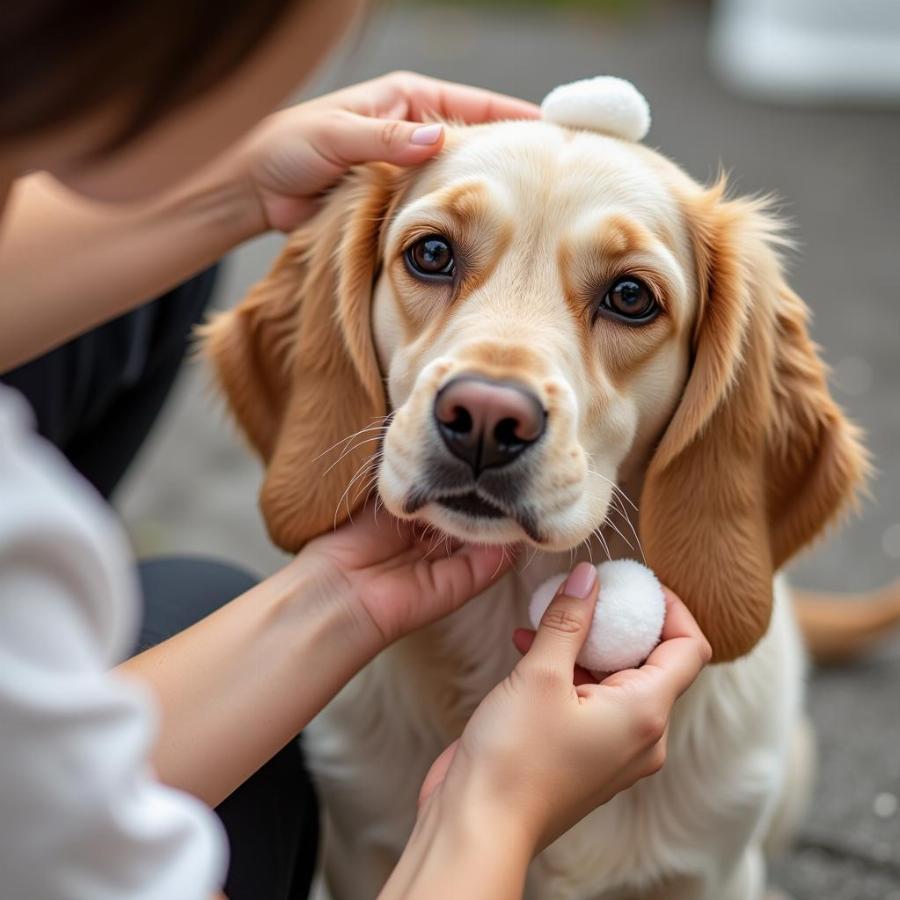Dogs with long ears have a unique charm and often possess endearing personalities. But those long, elegant ears require specific care and attention. This comprehensive guide explores everything you need to know about dog breeds with long ears, from choosing the right breed for your lifestyle to providing the best possible care for their distinctive feature.
Choosing the Right Long-Eared Breed for You
So, you’re thinking about bringing a long-eared dog into your life? Wonderful! But with so many breeds sporting those adorable floppy or pointed ears, how do you choose the right one? Consider your lifestyle, living space, and experience with dogs. A Basset Hound, known for its incredibly long ears and laid-back personality, might be perfect for a relaxed household, while a more energetic Cocker Spaniel might suit a more active family.
Factors to Consider When Choosing a Long-Eared Dog
- Grooming Needs: Long ears can be prone to infections if not properly cleaned. Are you prepared for the regular cleaning routine these breeds require?
- Activity Level: Some long-eared breeds are high-energy, while others are content to lounge around. Does the breed’s activity level match your lifestyle?
- Temperament: From the playful Beagle to the dignified Bloodhound, each breed has its own unique personality. Research different breeds to find one that fits your family’s dynamic.
- Health Concerns: Certain breeds are predisposed to specific health issues related to their ears. Be sure to research potential health problems and factor them into your decision.
Caring for Your Long-Eared Companion’s Ears
Long ears require special care to prevent infections and other problems. Regular cleaning is crucial. Here’s a simple guide:
- Gather your supplies: You’ll need a dog-specific ear cleaning solution, cotton balls or gauze, and treats to reward your furry friend.
- Gently lift the ear flap: Examine the ear canal for any signs of redness, swelling, or discharge.
- Apply the cleaning solution: Follow the instructions on the bottle carefully.
- Massage the base of the ear: This helps distribute the solution and loosen any debris.
- Wipe away excess solution and debris: Use clean cotton balls or gauze. Never insert anything into the ear canal.
 Vệ sinh tai cho chó
Vệ sinh tai cho chó
Common Ear Problems in Long-Eared Dogs
- Ear infections: Bacteria and yeast thrive in the warm, moist environment of long ears. Regular cleaning can help prevent infections.
- Ear mites: These tiny parasites can cause intense itching and inflammation.
- Hematomas: A hematoma is a blood-filled swelling that can occur if a dog shakes its head excessively due to irritation.
Popular Dog Breeds with Long Ears
From the playful and energetic to the calm and cuddly, here are some of the most popular dog breeds with long ears:
- Basset Hound
- Beagle
- Bloodhound
- Cocker Spaniel
- Dachshund
- Afghan Hound
“Regular ear cleaning is essential for the health and well-being of your long-eared dog,” says Dr. Emily Carter, a veterinarian specializing in canine health. “It’s a simple procedure that can prevent a multitude of problems.”
Living with a Long-Eared Dog: Tips and Tricks
Living with a dog with long ears can be a rewarding experience. They are often affectionate and loyal companions. Here are some tips to make your life together even better:
- Keep their ears dry: After swimming or bathing, dry their ears thoroughly to prevent infections.
- Regular vet checkups: Schedule regular checkups with your veterinarian to monitor their ear health.
- Diet: A healthy diet contributes to overall health, including ear health.
“Long-eared dogs bring so much joy to their owners,” says renowned dog trainer, Mark Johnson. “Their expressive ears add to their charming personalities.”
Conclusion
Dogs with long ears are truly special. Their unique feature adds to their charm and appeal. By understanding their specific needs and providing proper care, you can ensure a happy and healthy life for your long-eared companion. Remember, regular ear cleaning and attention to their overall health are key to preventing potential problems. long ear dogs can truly enrich your life.
FAQ
- How often should I clean my long-eared dog’s ears? Generally, once or twice a week is sufficient, but consult your vet for specific recommendations.
- What are the signs of an ear infection? Redness, swelling, discharge, odor, and excessive scratching are common signs.
- Can I use human ear cleaning solution on my dog? No, always use a dog-specific ear cleaning solution.
- What should I do if I suspect my dog has an ear infection? Contact your veterinarian immediately.
- Are all long-eared dogs prone to ear infections? While long-eared dogs are more susceptible, not all of them develop infections.
- What is the best way to dry my dog’s ears after swimming? Use a soft towel to gently pat the ears dry, or a dog-specific ear dryer.
- Are there any specific breeds of dogs with heart failure symptoms that have long ears? While certain heart conditions might be more prevalent in some long-eared breeds, the ear length itself isn’t a direct factor in heart failure.
Related Articles
You might also be interested in reading more about dogs shed the least.
Beaut Dogs
Beaut Dogs is your trusted source for all things related to dog care, providing expert advice and resources to help you navigate the wonderful world of dog ownership. From breed information to health tips, we’re here to support you every step of the way. When you need assistance, please contact Email: [email protected] so that Beaut Dogs can answer in detail and accurately. Visit https://beautdogs.com today to learn more.